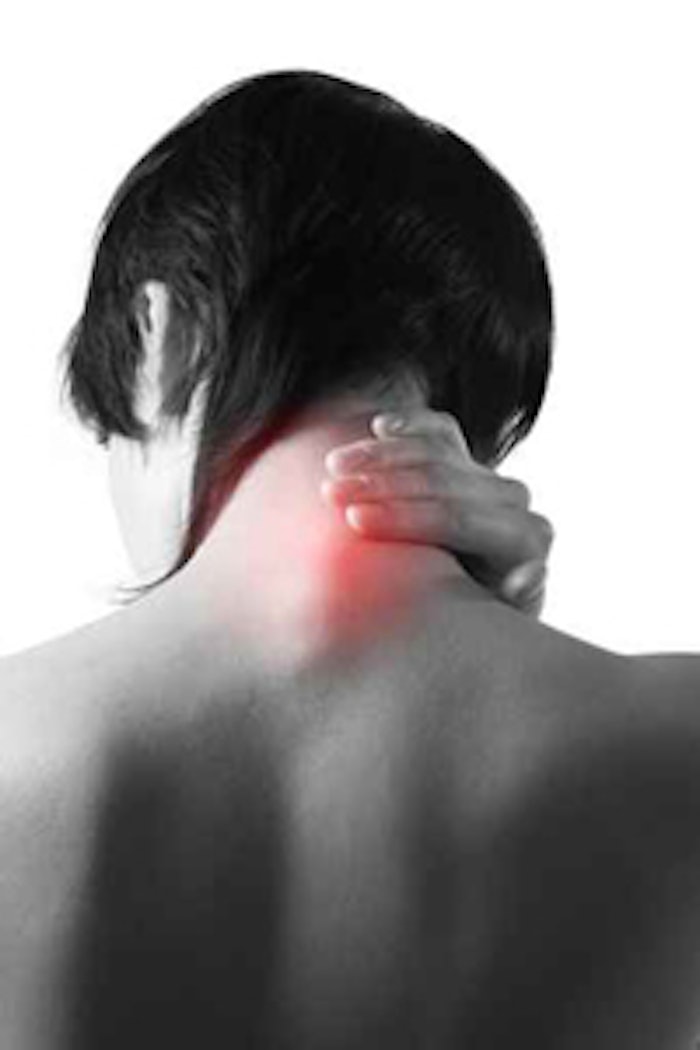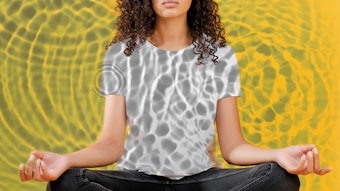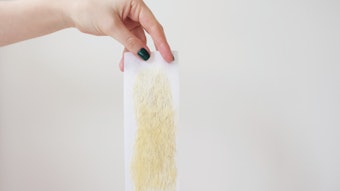
Research conducted under a grant from the National Rosacea Society shows stress is more likely to trigger an episode of rosacea than just about any other event. Long-term stress—the kind so many are tortured by these days—has been shown to lower the immune system while elevating inflammation, shortening chromosomes, damaging genes and devouring proteins in muscles, organs and, most significant to estheticians, skin.
In fact, stress is insidious, affecting every cell in the body, not just those on the surface of the skin. According to a report on ScienceDaily.com, “Stress causes deterioration in everything from your gums to your heart and can make you more susceptible to everything from the common cold to cancer.”1 Stress, of course, shows up in the skin; dermatologists and estheticians tell me that more than 80% of their clients now seek help for conditions linked to stress. These conditions range from well-known stress-related diseases, such as psoriasis, eczema, seborrheic dermatitis or acne, to more subtly linked disorders, including hair loss, ridged or brittle nails, hives, fever blisters, shingles, increased allergies and excessively dry, itchy skin.
Most important to esthetic practices, stress appears to be the second greatest factor in skin aging. After numerous studies examining the stress-skin connection, researchers now believe the actions of hormones, neuropeptides and other signaling molecules released during stress may be second only to ultraviolet (UV) light when it comes to tearing down the skin and speeding up the aging process.2 Because, similar to UV light, stress takes its toll on the epidermis and the dermis, their proteins and even the DNA inside individual skin cells, quickening the aging cycle by as many as six years. To make things worse, for some reason still unknown to researchers, women are much more likely to show signs of aging under the influence of chronic stress than men.
Stress and appearance
Unwanted skin changes have a profoundly negative impact on stress levels. Feeling bad about appearance only detracts from the ability to cope and care for yourself and the people in your life, piling on more stress and making disappointing or disastrous events even harder to tolerate. The stress that can be felt undermines your looks, adding more stress, which further undermines your appearance. It’s a vicious cycle; one to which every person is susceptible.
As those who have practiced esthetics for years can attest, rather than an effort at vanity, keeping a pleasing appearance is vital to a person’s well-being. It’s linked to self-esteem and self-worth, helps you feel included in society and “touchable” by those with whom you come in contact. As humans, how you look is key to identifying yourself from others, and stress can shake you to the very core when it takes a toll on your skin.
Because most don’t think of stress as having anything more to do with skin than its well-known connection to acne, its impact is often missed on those who don’t suffer from the skin disease. This is especially true nowadays with stress levels at record highs and caring for health at record lows. All the measures taken to keep yourself in shape, such as eating healthy and exercising, goes by the wayside when chronic, unrelenting stress enters your life. You feel out of control—drinking too much, eating the wrong things, not getting enough sleep—all of which exacerbate stress instead of helping regain the balance that is craved.
Yet, say psychologists, that’s exactly the time a routine of personal care should be adhered to that really is, well, personal. You need to eat your veggies, steer clear of sugar and empty carbs, take moments to focus inward, paced with slow, gut-level breaths, maintain your skin care routine and be sure to make quality time for family, friends and, most sacred of all, yourself.
Stress and touch
To anyone who’s watched a tightly wound client lie down on a massage table then listened as the snores of deep sleep overtake the person receiving a relaxing touch, it comes as no surprise that touch lowers stress. Studies show that those who don’t have friends or family in daily life—who don’t have anyone at all to touch or be touched by—feel more out of control and suffer stress-related illnesses at higher rates than those who do.3 The elderly, widowed, divorced and people who are at odds with their spouses or children are especially susceptible because they don’t just lack the touch of someone who cares, they frequently feel unloved, unwanted and unattractive. They have the worst kind of stress, and perhaps the most common: feeling abandoned and not knowing how to revive their connections with other people. This is especially true with older members of society. Oddly, feelings of aloneness are often emphasized by a lack of oxytocin, the bonding hormone that’s triggered most simply by a caring touch.
Oxytocin is what University of California, Los Angeles (UCLA) psychologist Shelley Taylor, PhD, says underlies women’s need to “tend and befriend” during times of stress, opening them up to deeper connections with those around them, reducing the fear of being alone and even lowering blood pressure and heart rate.2 At least one UCLA study has shown that women release this hormone when they’re simply in an environment with other women.4 Although the study was conducted on women who worked in the same office, it’s not too far of a stretch to expect this stress-reducing hormone will be released when women enter the cocooning atmosphere of a spa, or are touched by a caring esthetician or massage therapist during a treatment. That said, it is important to make sure your touch is more caring than cursory, more gentle than clinical. You need to show you truly care for the people who place themselves in your care.
As one esthetician recently told me, “We need to remember that we’re often the only person who touches a client. During these times where so many of our clients are suffering from intense stress and feelings of loneliness or abandonment, we need to build touch into every phase of our facials, extending beyond massaging the face and neck to making sure we give everyone that extra hand and foot massage while a mask is drying, even if it’s not included in the price of the treatment.”
As proof grows to include massage in an effective stress-reduction routine, some psychologists and psychotherapists are adding massage therapists to their office staffs. Dermatologists, plastic surgeons and others may not be far behind. New evidence from scientists at Johns Hopkins University in Baltimore, showed that mice under stress developed skin cancers in less than half the time of nonstressed mice when both were exposed to UV light.5 Other researchers have shown the time it takes wounds to heal can be prolonged in people who experience even short-term stress, such as a job interview or an argument with their spouse.6
Oddly, besides massage, humming a little tune can also speed up wound-repair. It turns out humming through the nose elevates nitric oxide in the blood, delivering a stress-reducing effect. Levels of the gas also climb in skin tissues and cells, promoting wound-healing by stimulating collagen production and dilating blood vessels to enhance oxygenation and centralize immune cells vital for repair to damaged tissues.2
Stress and essential oils
The stress-reduction response can be strengthened with essential oils of chamomile (Anthemis nobilis), lavender (Lavender officinalis), lavandin (Lavandula hybrida), geranium (Pelargonium graveolens), vanilla (Vanilla planifolia) and ylang-ylang (Cananga odorata). In scientific tests conducted in Japan, the United States, Britain, France and several other countries, all have been found to physically reduce symptoms of stress, most likely due to their effects on the sympathetic or parasympathetic nervous systems that underscore the stress response.7 Interestingly, depending upon whether a person is jumpy or overtired, lavender stimulates the appropriate tract of the nervous system, calming nerves or making more alert. Lavender’s dual nature is probably why it’s the most well-known and well-loved of the stress-relieving essential oils. Almost everyone responds positively to lavender oil.
Peppermint—often used to energize those who are so stressed they’re exhausted—is believed to work by stimulating the trigeminal nerve near the eyes, nose, mouth and along the lower half of the face. Brain waves intensify, sharpening the mind and quickening reaction time. In short, peppermint wakes you up, making you alert and able to think more clearly.
Other scents have also been shown by psychologists or medical researchers to relieve stress. In one Yale study, students who were conditioned to relax when they smelled a particular fragrance were asked to take a test. During one part of the test, they were exposed to the fragrance. Just smelling it reduced their blood pressure by three to five points.8 The same concept is at work when vanillalike heliotropin is used to relax MRI patients, while shoppers tend to buy more when exposed to scents in the chocolate family, which induce relaxation by calming the trigeminal nerve in the face.9 Bergamot, chamomile and rose essential oils have all been linked to endorphin release, the happiness hormone that’s also known as “natural morphine” because it attaches to brain, skin and other cells in the same place as morphine, inducing a similar effect. Running and eating chocolate also stimulate endorphins, which may be the root of exercise addiction and chocolate cravings.
Last year, researchers at Johns Hopkins University and The Hebrew University of Jerusalem discovered psychoactive effects from incensole acetate, a constituent in frankincense used for several millennia in religious ceremonies throughout the world.10 The chemical lowers anxiety and causes antidepressive behavior in mice by activating a neural protein that is also present in the human brain. Although its effects have yet to be proven in humans, the researchers are hopeful their findings will lead to a new class of drugs to treat anxiety and depression. In the meantime, burning a little incense from time to time might be a gentle way to relieve stress.
Also, if you use a particular essential oil or blend in your treatments, you may have anchored an oxytocin release response in your clients. Sending the scent home with your clients will help them relax by simply smelling the oil. You can also try a little sensory marketing using the essential oil to lightly scent postcards reminding your clients to schedule an appointment. If a client is anchored to the oil, they might be more likely to call and schedule an appointment.
Build in more touch
In this stress-filled world, clients need skin care professionals to keep them pulled together so they can go out and tackle the challenges in their lives. Review all points of interaction you have with your clients, from the initial greeting to each treatment on your menu to the way your clients end their spa experience. Look for opportunities to build in more touch time, more ways of expressing care, more chances to communicate calm via all the senses. By reviewing each element of the spa experience, you’ll be able to layer small but meaningful touches that will deepen the stress-reduction dynamic for even the most stressed-out clients.
References
- Understanding the Role of Stress in Just About Everything, Science Daily (Jan 11, 2008)
- A Weschler, The Mind-Body Connection: 9 Days to Reverse Stress Aging and Reveal More Youthful Beautiful Skin, Simon & Schuster, New York (2008)
- SE Taylor, LC Lewis, BP Gruenewald, TL Grung, JA Updergraff, Female Response to Stress: Tend and Befriend, Not Fight or Flight, Psychological Review 107(3) 41–42
- UCLA Researchers Identify Key Biobehavioral Pattern Used by Women to Manage Stress, Science Daily (May 22, 2000)
- Stressed Mice Quicker to Get Skin Cancer, Johns Hopkins Medicine press release (Dec 8, 2004)
- Stress Substantially Slows Human Body’s Ability to Heal, Archives of General Psychiatry (Dec 5, 2005)
- Use of aromatherapy with hospice patients to decrease pain, anxiety and depression and to promote an increased sense of well-being, Am J of Hosp and Pall Med 19(6) 381–386
- SR Scantling, Is There a Fragrant Solution to Low Sexual Desire? Intimacy, Sex & Relationship (Oct 14, 2007)
- Fragrance administration to reduce anxiety during MR imaging, Journal of Magnetic Resonance Imaging 4(4) 623–626 (2005)
- Burning Incense is Psychoactive: New Class of Antidepressants Might be Right Under Our Noses, Science Daily (May 20, 2008)










